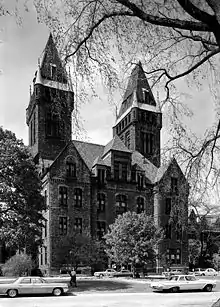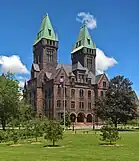| Richardson Olmsted Complex | |
|---|---|
 | |
| Former names | Buffalo State Asylum for the Insane, Buffalo State Hospital, H.H. Richardson Complex, Hotel Henry |
| Alternative names | The Richardson Hotel |
| General information | |
| Status | Used as a hotel |
| Location | 444 Forest Avenue, Buffalo, New York 14222 |
| Coordinates | 42°55′43″N 078°52′55.1″W / 42.92861°N 78.881972°W |
| Named for | Henry Hobson Richardson |
Richardson Olmsted Complex | |
| Area | 93 acres (38 ha) |
| Built | 1872 |
| Architect | Henry Hobson Richardson |
| Architectural style | Richardsonian Romanesque |
| NRHP reference No. | 73001186 |
| Significant dates | |
| Added to NRHP | January 12, 1973[1] |
| Designated NHL | June 24, 1986[2] |
| Renovated | 2006-2023 |
| Other information | |
| Number of rooms | 88 |
The Richardson Olmsted Complex in Buffalo, New York, United States, was designated a National Historic Landmark in 1986.[2][3] The site was designed by the American architect Henry Hobson Richardson in concert with the landscape team of Frederick Law Olmsted, landscape architect of New York City's Central Park, and Calvert Vaux in the late 1800s, incorporating a system of treatment for people with mental illness developed by Thomas Story Kirkbride. Over the years, as mental health treatment changed and resources were diverted, the buildings and grounds began a slow deterioration. In 2006, the Richardson Center Corporation was formed to restore the buildings. The building was renovated and opened in 2023 at The Richardson Hotel.
History and architecture
The large Medina red sandstone and brick hospital buildings were designed in 1870 in the Kirkbride Plan by architect Henry Hobson Richardson with grounds by landscape architect Frederick Law Olmsted.[4] At the time of construction completion, the facility was formally known as the Buffalo State Asylum for the Insane.[5] The campus consists of a central administrative tower and five pavilions or wards progressively set back on each side, for eleven buildings total, all connected by short curved two-story corridors. Patients were segregated by sex, males on the east side, females on the west. The wards housed patients until the mid-1970s. The central administration building was used for offices until 1994.[1]
The campus, the largest commission of Richardson's career, marks the advent of his characteristic Romanesque Revival style. When emulated by later architects, this style is referred to as Richardsonian Romanesque. It has been the subject of a long-term preservation campaign. Nevertheless, three pavilions on the east side were demolished in the 1970s to make way for newer psychiatric facilities.[6] In 1927, the northern farmlands were transferred back to the State for the development of what is today Buffalo State College.[7]
In 1973, the Asylum was added to the National Register of Historic Places and in 1986, it was designated a National Historic Landmark.[1] Patient records from 1881 to 1975 are in the collection of the New York State Archives in Albany, NY.[8][9][10] Architectural plans and drawings are in the H.H. Richardson Collection in the Houghton Library at Harvard University.[11]
Preservation efforts
The Preservation Coalition of Erie County (renamed "Preservation Buffalo Niagara" in October 2008) filed a lawsuit resulting in New York State establishing the Richardson Center Corporation in 2006 to rehabilitate the site and the State committing $100 million towards rehabilitation. Both former New York State Assembly Member Sam Hoyt, and former Buffalo State College President Muriel A. Howard, were involved in plans for the restoration and reuse of the Richardson.[12]
Perimeter fencing and lighting were installed and a Peace Officer was hired to conduct regular patrols and prevent and deter further crime at the complex.[13] On March 5, 2008, stabilization began with the most severely damaged buildings, including the roof and down-spouts.[14] Stabilization was completed in 2012.[15]
On April 10, 2010, a fire occurred. The cause of the fire was under investigation. Damage was estimated at $200,000.[16]
In 2013, the South Lawn landscape on the property was completed.[17]
During the planning stages, the Richardson Center Corporation has used an active public process, aimed to help to inform the Master Plan during all phases of redevelopment for the Campus, including several public meetings. A Community Advisory Group includes representatives from the adjacent neighborhoods, business districts, cultural institutions, Buffalo Psychiatric Center, SUNY Buffalo State, and historic preservation groups.[18]
Currently, the building is being restored by Douglas Development Corporation and Antunovich Associates.
Redevelopment as a hotel
Hotel Henry
In January 2013, plans were announced to redevelop one third of the Campus into Hotel Henry Urban Resort Conference Center with a restaurant called 100 Acres, and the Buffalo Architecture Center, both within the Towers Building and two flanking buildings.[19]
The Hotel Henry Urban Resort Conference Center opened in April 2017 to acclaim; it was named one of the "World's Greatest Places" by Time Magazine in 2018.[20][21] Although the first two years were profitable, Hotel Henry was forced to close in February 2021 due to the COVID-19 pandemic.[21]
The Richardson Hotel
The hotel was again renovated, and re-opened in March 2023 under new management.[22] Renovations included re-arrangement of the restaurant areas, and the check-in desk was moved to the first floor.[22] The 88-room Richardson Hotel occupies four floors of three of the 13 Richardson-designed buildings on the site.[22] The hotel features a bar, cafe, restaurant, conference space and a ballroom at the top.[22] The space is decorated with antique furniture found in the basement, as well as about 300 large photographs of the property, some of which are historic and some contemporary photos taken by local photographers.[22]
In popular culture
In 1983 a portion of a ground floor hallway and one hospital room were prepared to appear as a maternity ward and used as a location for The Natural, where the character Roy Hobbs, as played by Robert Redford, was shown recovering from internal injuries.
Mount Massive Asylum, the main setting for the 2013 horror game Outlast, was modeled after the Richardson Olmsted Complex.[23]
References
- 1 2 3 "National Register Information System". National Register of Historic Places. National Park Service. July 9, 2010.
- 1 2 "Buffalo State Hospital". National Historic Landmark summary listing. National Park Service. September 18, 2007. Archived from the original on May 2, 2008.
- ↑ "Cultural Resource Information System (CRIS)" (Searchable database). New York State Office of Parks, Recreation and Historic Preservation. Retrieved April 1, 2016. Note: This includes T. Robins Brown (August 1972). "National Register of Historic Places Registration Form: Buffalo State Hospital" (PDF). Retrieved April 1, 2016., Caroline Pitts (n.d.). "National Register of Historic Places Registration Form: Buffalo State Asylum for the Insane (State Lunatic Asylum)" (PDF). Retrieved April 1, 2016., and Accompanying three photographs
- ↑ Carla Yanni, The Architecture of Madness: Insane Asylums in the United States (University of Minnesota Press, 2007) 127-139.
- ↑ "Richardson Olmsted Campus". Flynn Battaglia. Retrieved November 30, 2023.
- ↑ Archives: Architecture: A towering masterpiece: H.H. Richardson's Buffalo State Hospital, Buffalo Spree, Buffalo, NY, March/April 2000, Kowsky, F.R., Retrieved 15 December 2013.
- ↑ "History > Learn > The Richardson Olmsted Campus". www.richardson-olmsted.com. Retrieved August 22, 2016.
- ↑ "New York State Archives".
- ↑ Buffalo State Hospital patient case files, 1881-1920. New York State Office of Mental Health. OCLC 122346707.
- ↑ Buffalo State Hospital patient case files, 1920-1975. New York State Office of Mental Health. OCLC 82286416.
- ↑ "Henry Hobson Richardson Drawings: Buffalo State Hospital".
- ↑ Hoyt proposes civic panel for Richardson site, Buffalo News, Buffalo, NY: Berkshire Hathaway, 22 January 2004, Sommer, M., Retrieved 15 January 2014.
- ↑ "Stabilization > Learn > The Richardson Olmsted Campus". www.richardson-olmsted.com. Retrieved August 22, 2016.
- ↑ "Repairs underway at H.H. Richardson complex". Archived from the original on March 6, 2008.
- ↑ "Reuse Timeline > Learn > The Richardson Olmsted Campus". www.richardson-olmsted.com. Retrieved August 22, 2016.
- ↑ "Flames break out at closed psych center".
- ↑ "South Lawn > Learn > The Richardson Olmsted Campus". www.richardson-olmsted.com. Retrieved August 22, 2016.
- ↑ "Community > Support > The Richardson Olmsted Campus". www.richardson-olmsted.com. Retrieved August 22, 2016.
- ↑ "Governor Cuomo Announces First Phase of Redevelopment of Richardson Olmsted Campus In Buffalo". State of New York.
- ↑ Axelson, Ben (September 5, 2018). "PHOTOS: This Upstate NY hotel was just named one of the 'World's Greatest Places'". NYUP.com. New York Upstate. Retrieved December 29, 2023.
- 1 2 Khatib, Kelly (February 16, 2021). "Hotel Henry ending business operations due to pandemic". WIVB4. Archived from the original on April 15, 2023. Retrieved December 29, 2023.
- 1 2 3 4 5 Sommer, Mark (September 18, 2023). "'Absolutely gorgeous': The Richardson Hotel celebrates grand opening". The Buffalo News. Retrieved December 29, 2023.
- ↑ Russell, Brandon (October 25, 2014). "Outlast 2 In Development for PS4, Xbox One and PC". TechnoBuffalo. Retrieved June 11, 2019.
External links
- Official website
- Historic American Buildings Survey (HABS) No. NY-5606, "State Lunatic Asylum, 400 Forest Avenue, Buffalo, Erie County, NY", 8 photos, 8 data pages





